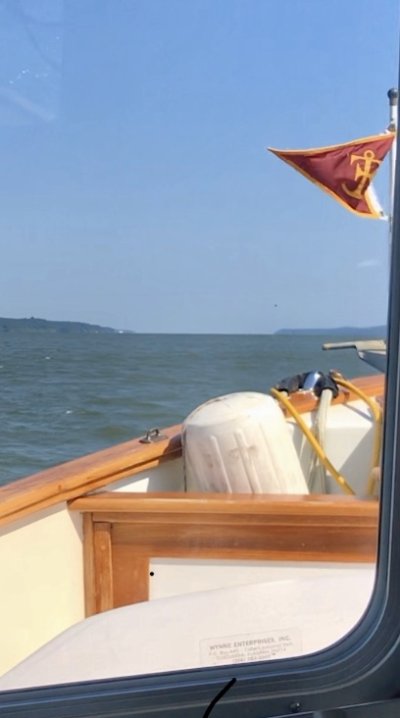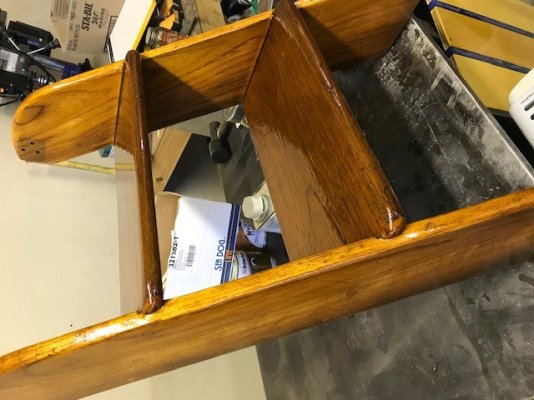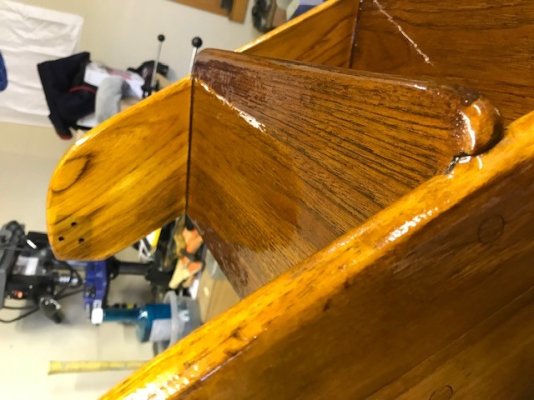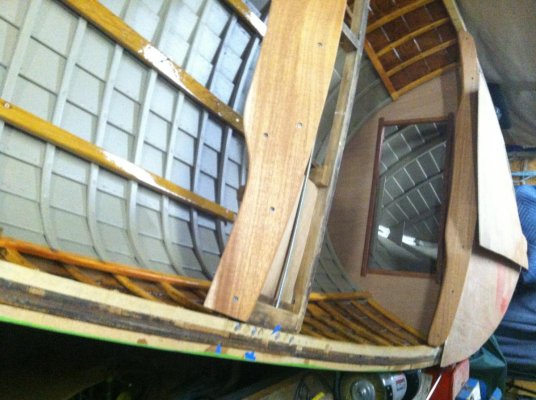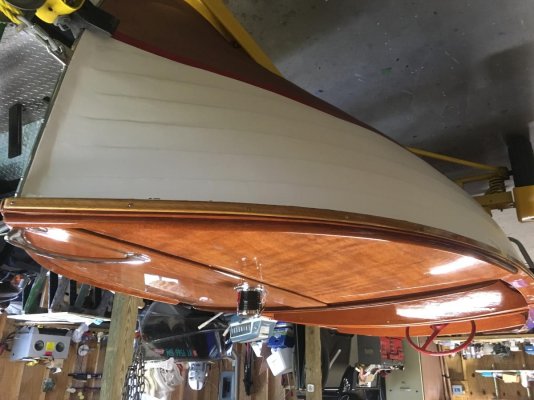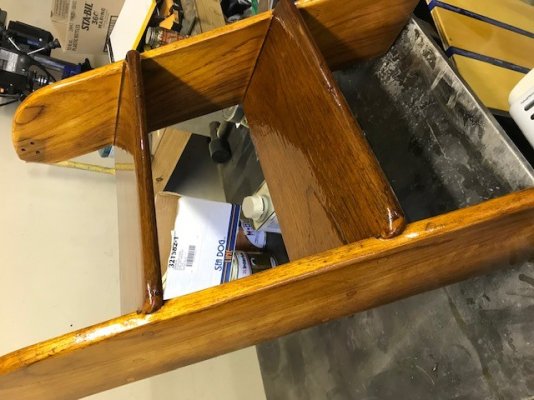You are using an out of date browser. It may not display this or other websites correctly.
You should upgrade or use an alternative browser.
You should upgrade or use an alternative browser.
Varnish, first time...
- Thread starter RonR
- Start date
The friendliest place on the web for anyone who enjoys boating.
If you have answers, please help by responding to the unanswered posts.
If you have answers, please help by responding to the unanswered posts.
So what are the thoughts on the ladder and steps.
Varnish the runners and keep the area you step on natural? Or should I oil them? Or should I varnish them and then add on some of the sticky backed black grippy things?
Currently they runners are varnish, the steps are natural, no oil no nothing.
Not found of the look, but its safe.
My steps from the main deck to the deck above the aft cabin and from the swim grid up the transom, have those white rubber tread pieces, so I have gloss varnish around them. The rubber bits are getting past their best before, after 39 years, so will likely get replaced soon.
The steps to the fly bridge are all teak, with a 1/4" raised tread area on each. That I leave to go grey, the rest varnished, and I like the look.
My boarding ladder, Curly Maple, I tried the non skid black strips, but they peeled, so I have gloss varnish now and prefer the look. In the rain, with care, and with hand holds at the rail, they are not slippery, so I will stick with the gloss look.
nobles9596
Veteran Member
- Joined
- May 23, 2018
- Messages
- 78
- Location
- USA
- Vessel Name
- Next Chapter
- Vessel Make
- 34' Marine Trader DC
I tried Cetol in the past and it did not last. I then redid it with Epiphanies and I am very happy with the results
RonR
Guru
OldDan1943
Guru
- Joined
- Oct 2, 2017
- Messages
- 10,595
- Location
- USA
- Vessel Name
- Kinja
- Vessel Make
- American Tug 34 #116 2008
Second coat is starting to seal it up and add some shine. I will hit this one with 250 and add the 3rd coat tonight.
Stop when you get to 10 coats. LOL
RonR
Guru
Stop when you get to 10 coats. LOL
I was thinking 8 should do the trick, we will see how it goes!
Drying is slow this time of year, it was 25 out this AM. And only about 50 in the garage.
OldDan1943
Guru
- Joined
- Oct 2, 2017
- Messages
- 10,595
- Location
- USA
- Vessel Name
- Kinja
- Vessel Make
- American Tug 34 #116 2008
I was thinking 8 should do the trick, we will see how it goes!
Drying is slow this time of year, it was 25 out this AM. And only about 50 in the garage.
Before each coat, use bronze wool to smooth it down then, a tack cloth to get all the varnish dust off the wood.
cabinetman1955
Veteran Member
Refinishing
The main reason for finish failure is not following manufactures recommendations . Get yourself a thermometer and a humidity meter make sure that you temperature and humidity are correct before finishing!
The main reason for finish failure is not following manufactures recommendations . Get yourself a thermometer and a humidity meter make sure that you temperature and humidity are correct before finishing!
I am wanting to re-varnish the rails, steps, ladder, doors. I can take everything but the rails off and bring them home this winter and tackle them one by one. I got the book Brightwork: The Art of Finishing Wood: Rebecca J. Wittman. I have read it twice and will use it as a reference once I start. After a few months of research my wife asked me a simple question that I never thought about. She asked what year was that book written and has anything new came out in the last 18 years that is better to use. Before her question I was leaning towards Interlux Schooner Varnish, as my local shop has every product they make and plenty in stock. I believe the current finish on the boat is also Schooner as I have found two open cans tucked away with a few bits of sandpaper and some foam brushes, the stuff that is out of the weather looks good still and I know it has not been touched for 5 years or more.
The shop owners state its user friendly for my first time, and Rebecca Wittman calls it out in her book as one she used often. My only prior experience was with some seat backs I used a water based clear on, they look good, but have no UV protection (inside a car). So I understand most of the steps needed to create a deep gloss with no dirt/dog hair/dust and how long it takes to build up just a few coats in a controlled environment.
So without starting world war 3 on swapping to Cetol Marine or painting it, any other recommendations? I love the look, I'm able to physically do it, and I understand that once I go down this road.. it never ends.
Our boat is a 1971 Egg Harbor Sport Fisher, it has a full camper canvas on the rear and the boat is under cover in the harbor. We live in Everett Washington and I know some brands do better in the PNW than others.
I have read a little on a two part system, but the shop owners state its best left to a professional. If there are other treads on this topic please send them my way, I did a simple search but found most are going to Cetol or paint.
Thank you
Ron R.
captaindah
Member
- Joined
- Sep 12, 2012
- Messages
- 11
- Location
- United States of America
- Vessel Name
- Sovereignty
- Vessel Make
- Kadey-Krogen Manatee
Applying varnish
I live aboard a 1986 Kadey Krogen Manatee. It has a great deal of interior and exterior teak. I apply Smith's Clear Penetrating Epoxy to any bare wood prior to varnishing. While it is still wet, I apply coat after coat of Honey Teak. This causes a chemical bond with the Smith's.
Annually, i scuff the Honey Teak with a Scotch Bright (red) pad, and lay additional coats of Honey Teak, coat on coat while it is tackey.
By the way, I never varnish any surface on which people will walk. Varnish, or any other sealant, is too slippery. I leave them natural and clear them weio Tide, when they show dirt.
I live aboard a 1986 Kadey Krogen Manatee. It has a great deal of interior and exterior teak. I apply Smith's Clear Penetrating Epoxy to any bare wood prior to varnishing. While it is still wet, I apply coat after coat of Honey Teak. This causes a chemical bond with the Smith's.
Annually, i scuff the Honey Teak with a Scotch Bright (red) pad, and lay additional coats of Honey Teak, coat on coat while it is tackey.
By the way, I never varnish any surface on which people will walk. Varnish, or any other sealant, is too slippery. I leave them natural and clear them weio Tide, when they show dirt.
Last edited:
Epifanes hands down
Epifanes works great when done according to the directions. Thin it as directed and pay close attention to humidity and temperature. You can build it up using the wood finish gloss which by the way is formulated for teak. You should then sand the last coat of wood finish gloss and put on a top coat of their clear varnish. It has better shine and better uv protection. Use 4 inch foam rollers from home depot and FEN foam brushes for tipping off after application by the rollers. If you want a real good job sand in between each two coats of the wood finish gloss because it flattens the surface and subsequent coats go on much better. Attached are a couple of before and after pictures that my 13 year old grandson just did following the aforementioned process....no pressure!!
Epifanes works great when done according to the directions. Thin it as directed and pay close attention to humidity and temperature. You can build it up using the wood finish gloss which by the way is formulated for teak. You should then sand the last coat of wood finish gloss and put on a top coat of their clear varnish. It has better shine and better uv protection. Use 4 inch foam rollers from home depot and FEN foam brushes for tipping off after application by the rollers. If you want a real good job sand in between each two coats of the wood finish gloss because it flattens the surface and subsequent coats go on much better. Attached are a couple of before and after pictures that my 13 year old grandson just did following the aforementioned process....no pressure!!
Attachments
castellah22
Veteran Member
- Joined
- Aug 20, 2010
- Messages
- 29
- Location
- UNITED KINGDOM
- Vessel Name
- Sovereign GB
- Vessel Make
- Grand Banks 32
use wood skin by international
jrhodes777
Veteran Member
- Joined
- Jan 3, 2017
- Messages
- 33
- Location
- United States
- Vessel Name
- Wanderlust
- Vessel Make
- 1988 46' Grand Banks Classic
Brightwork Options
For me there are two options. First is three coats of West System epoxy using 207 clear hardener followed by at least four coats of Epifanes varnish. This system provides a very hard deep classic finish. The biggest problem is repairing when the finish is damaged through the epoxy. Also, if you don't maintain the UV protective varnish over coat the epoxy will fail rapidly in the sun. Removing epoxy is much harder than varnish! However if you maintain the over coat of varnish the epoxy/varnish system can last extremely long. We decided four years ago to use three coats Cetol natural teak over coated with
two coats Cetol clear gloss. I have been very impressed with the ease of repairing any damage and simplicity of annual recoat of gloss. However it does not have the depth and depth of varnish.
For me there are two options. First is three coats of West System epoxy using 207 clear hardener followed by at least four coats of Epifanes varnish. This system provides a very hard deep classic finish. The biggest problem is repairing when the finish is damaged through the epoxy. Also, if you don't maintain the UV protective varnish over coat the epoxy will fail rapidly in the sun. Removing epoxy is much harder than varnish! However if you maintain the over coat of varnish the epoxy/varnish system can last extremely long. We decided four years ago to use three coats Cetol natural teak over coated with
two coats Cetol clear gloss. I have been very impressed with the ease of repairing any damage and simplicity of annual recoat of gloss. However it does not have the depth and depth of varnish.
OldDan1943
Guru
- Joined
- Oct 2, 2017
- Messages
- 10,595
- Location
- USA
- Vessel Name
- Kinja
- Vessel Make
- American Tug 34 #116 2008
I am very proud to say, my American Tug has NO exterior teak. Advantage, I can take more naps.
CaptRowlands
Veteran Member
- Joined
- Jul 2, 2018
- Messages
- 36
- Location
- United States
- Vessel Name
- Myrtea / Harbor Quest
- Vessel Make
- CL Bermuda 30, Egg 40
My twos cents on applying and maintaining a varnish finish.
Rebecca's book is a great resource as are the manufacturer's instructions found on the can or brochure. Follow these and you won't go wrong. Keep in mind he thickness of the finish and maintenance will determine longevity.
My two cents; use quality scrapers and heat gun to speed up removal of the old finish. Use quality sandpaper and sanding tools then don't hesitate to change paper often and go thru the grits. Vacuum thoroughly and use a tack cloth. Lastly, pay particular attention to conditions of temperature and humidity. Allow enough time for the applied finish to dry before dew occurs and allow it to cure before sanding.
I have maintained my varnished wooden boats for over (30) years and receive compliments regularly. My process for teak is to sand bare wood thru the grits to 150. Apply fill coat of Epifanes Woodfinish per can instructions. Allow to cure hard. Sand with 150 to remove all raised grain then apply 2-3 coats of Woodfinish per can instructions. Allow to cure hard. Sand lightly with 150 then 250/300. For exterior work, apply as many additional coats as your time will allow then allow to thoroughly cure (in my experience a week). Lightly sand with 250/300 then top coat with Epifanes traditional varnish.
Rebecca's book is a great resource as are the manufacturer's instructions found on the can or brochure. Follow these and you won't go wrong. Keep in mind he thickness of the finish and maintenance will determine longevity.
My two cents; use quality scrapers and heat gun to speed up removal of the old finish. Use quality sandpaper and sanding tools then don't hesitate to change paper often and go thru the grits. Vacuum thoroughly and use a tack cloth. Lastly, pay particular attention to conditions of temperature and humidity. Allow enough time for the applied finish to dry before dew occurs and allow it to cure before sanding.
I have maintained my varnished wooden boats for over (30) years and receive compliments regularly. My process for teak is to sand bare wood thru the grits to 150. Apply fill coat of Epifanes Woodfinish per can instructions. Allow to cure hard. Sand with 150 to remove all raised grain then apply 2-3 coats of Woodfinish per can instructions. Allow to cure hard. Sand lightly with 150 then 250/300. For exterior work, apply as many additional coats as your time will allow then allow to thoroughly cure (in my experience a week). Lightly sand with 250/300 then top coat with Epifanes traditional varnish.
dieck
Member
- Joined
- Mar 4, 2017
- Messages
- 11
- Location
- Germany
- Vessel Name
- Brigant
- Vessel Make
- Cantieri Navali Liguri / 1969/ 51ft
I have not found a varnish that handles the environment well. After sanding thw wron varnish down to the bare wood I have been using teakoil on all wood except the deck. The deck we leave grey. The teak oil is easy to apply and we do this on the rails 3 times per year. On all other outside vertical surfaces max. 1 time per year.
When I was younger, I went the varnish on everything outside route. It is a beautiful finish. These days, I just Sikkens Cetol and I am more than happy. Not quite as pretty, but not nearly as much work and maintenance.
RonR
Guru
I am up to coat #5. Its looking good, and I am sanding with 220 right now between coats with a orbital sander and hand sand in the tight areas. I will change out to 300ish when I get close to the last few coats as there are a lot of high/low spots that need filled in from years of neglect. I have the garage temp set at 65 now and the coats take a good day and a half to be workable again. I am in no hurry, I have all winter! I had planned on taking more items off the boat and sanding/varnishing, but the large amounts of dust for a multi item project makes it problematic in keeping the garage clean enough to coat without dust. So I will do just one at a time.
I have a few bronze fittings that I am on the fence about. For the steps there are two keepers in the top that allow it to be moved from Port/Starboard depending on how your docked. I took them off and soaked them in white vinegar to remove all the black. And then I polished them with Mothers. I am unsure if I should clean and then clear coat them before I reinstall them or just let them go back to black as I know they will in about 4-6 months on the water.
I have also thought about making a make shift clean room in the garage for varnishing and adding one more heater to get the temps in the clean room to 70+. But I am not sure its worth the effort and cost. Right now I coat, let it sit in the heated garage for a day then bring it in the house and let it sit about 10' from the fireplace. It bakes on the finish well. But it also stinks up the house and I don't think the wife will want this going on all winter. I have also thought about adding some kind of air filtration unit in the garage to help with the VOC's emitted from the drying process. I was looking into a charcoal filter set up like the simi-pro's use for indoor growing operations. Has anyone tried something like this?
Thank you everyone for all the tips/tricks and pictures of your projects. I think we need to start a separate topic forum for just wood finishing!
I have a few bronze fittings that I am on the fence about. For the steps there are two keepers in the top that allow it to be moved from Port/Starboard depending on how your docked. I took them off and soaked them in white vinegar to remove all the black. And then I polished them with Mothers. I am unsure if I should clean and then clear coat them before I reinstall them or just let them go back to black as I know they will in about 4-6 months on the water.
I have also thought about making a make shift clean room in the garage for varnishing and adding one more heater to get the temps in the clean room to 70+. But I am not sure its worth the effort and cost. Right now I coat, let it sit in the heated garage for a day then bring it in the house and let it sit about 10' from the fireplace. It bakes on the finish well. But it also stinks up the house and I don't think the wife will want this going on all winter. I have also thought about adding some kind of air filtration unit in the garage to help with the VOC's emitted from the drying process. I was looking into a charcoal filter set up like the simi-pro's use for indoor growing operations. Has anyone tried something like this?
Thank you everyone for all the tips/tricks and pictures of your projects. I think we need to start a separate topic forum for just wood finishing!
Last edited:
OldDan1943
Guru
- Joined
- Oct 2, 2017
- Messages
- 10,595
- Location
- USA
- Vessel Name
- Kinja
- Vessel Make
- American Tug 34 #116 2008
I have a few bronze fittings that I am on the fence about. For the steps there are two keepers in the top that allow it to be moved from Port/Starboard depending on how your docked. I took them off and soaked them in white vinegar to remove all the black. And then I polished them with Mothers. I am unsure if I should clean and then clear coat them before I reinstall them or just let them go back to black as I know they will in about 4-6 months on the water.
Just let the bronze fitting develop that special patina. Look more salty plus you don't have to 'touch them up' when the clear coat begins to wear.
Ron, it might be back there someplace but what varnish did you end up using? Use 320 paper between coats after you have gotten it flattened enough. You can get the black stains out of the wood prior to varnishing by bleaching the wood.
Redhook98
Senior Member
- Joined
- Jun 26, 2019
- Messages
- 365
- Location
- US
- Vessel Name
- Tatoosh
- Vessel Make
- 1979 49ft Marine Trader RPH
On the second to last coat on my steps, I dusted them with the non-skid additive you add to paint. After that dried, I coated the steps only with one more coat of varnish. Turned out great and non slick at all.
RonR
Guru
Ron, it might be back there someplace but what varnish did you end up using? Use 320 paper between coats after you have gotten it flattened enough. You can get the black stains out of the wood prior to varnishing by bleaching the wood.
Interlux Schooner Gold.
Never thought about bleaching, thank you for the tips.
RonR
Guru
On the second to last coat on my steps, I dusted them with the non-skid additive you add to paint. After that dried, I coated the steps only with one more coat of varnish. Turned out great and non slick at all.
I had thought about that, but I was worried that in a few years when its time to do this again the non-skid additive would be difficult to remove.
What product do you use?
Redhook98
Senior Member
- Joined
- Jun 26, 2019
- Messages
- 365
- Location
- US
- Vessel Name
- Tatoosh
- Vessel Make
- 1979 49ft Marine Trader RPH
I had thought about that, but I was worried that in a few years when its time to do this again the non-skid additive would be difficult to remove.
What product do you use?
I used Flagship varnish and the additive was an off the shelf Rustoleum non-skid paint additive. When it comes time to strip it again, I will just use heat.
RonR
Guru
I am on coat #8. Flat and mirror like on the sides, the steps are almost as nice but will be mostly covered with non-slip tread. I still end up with a few high/low spots when I coat and end up sanding it smooth and flat a day or so later when its cured. Any tips on getting the last coat laid without needing any sanding to correct? I know if I was to spray it I could get it done, but I would like to proceeded with the foam brush as that's what I will be using on the non-removable items. Or can I sand it with something like 1000-1500 and buff for a shine?
Portage_Bay
Guru
- Joined
- Oct 19, 2015
- Messages
- 2,453
- Location
- United States
- Vessel Name
- Pacific Myst
- Vessel Make
- West Bay 4500
Years ago, in the 70s, I rebuilt the transom on an antique woody. I used Captain's spar varnish, roll and tip, sanding with very fine paper (don't remember the grit) between coats. When done it was gorgeous. The Honduras Mahogany looked like it was under glass. For a while. Then the varnish peeled off in sheets. A local bright work expert told me I'd sanded with too fine grit and to not go finer than 180. After I stripped it off and did it again it lasted a long time. In the end the work sanded with 180 looked just as good as the first go round.
CaptRowlands
Veteran Member
- Joined
- Jul 2, 2018
- Messages
- 36
- Location
- United States
- Vessel Name
- Myrtea / Harbor Quest
- Vessel Make
- CL Bermuda 30, Egg 40
Try thinning the last ‘mirror coat” which should facilitate glow and therefore leveling.
captaindah
Member
- Joined
- Sep 12, 2012
- Messages
- 11
- Location
- United States of America
- Vessel Name
- Sovereignty
- Vessel Make
- Kadey-Krogen Manatee
It's a boat, not a Steinway piano.* Like a person, the wrinkles portend wisdom.* If the surface were perfect you and especially your guests, would live in fear of damaging it and thusly their comfort would be nonexistant.
A Maine craftsman who built six coffee tables a year, would only build one for someone he had met, come to know, and liked.* His tables were prized and the demand far exceeded his output.
After agreeing to build a table for a (new) friend, he would select a cross cut tree for their table.* He would painstakingly finish it to perfection.* Once completed he would invite them to come to his shop to pick it up.* He would not ship a table without the meeting.
With all assembled around the table, he would light a cigarette and tell the table owners why he selected the particular tree cross section for their table.* He would go into great detail about the tables preparation and with the cigarette half consumed he would lay it on the table near an edge while explaining the finishing of the table.
When his story completed, he would tell them that now that it was blemished they could live with it.* Otherwise all their friends and family would live in fear of being the first to abuse it.
If you want to show your perfection at finishing wood,* pick a piece, finish it, and frame it behind glass.
Let people relax and enjoy boating without and yours.
David
A Maine craftsman who built six coffee tables a year, would only build one for someone he had met, come to know, and liked.* His tables were prized and the demand far exceeded his output.
After agreeing to build a table for a (new) friend, he would select a cross cut tree for their table.* He would painstakingly finish it to perfection.* Once completed he would invite them to come to his shop to pick it up.* He would not ship a table without the meeting.
With all assembled around the table, he would light a cigarette and tell the table owners why he selected the particular tree cross section for their table.* He would go into great detail about the tables preparation and with the cigarette half consumed he would lay it on the table near an edge while explaining the finishing of the table.
When his story completed, he would tell them that now that it was blemished they could live with it.* Otherwise all their friends and family would live in fear of being the first to abuse it.
If you want to show your perfection at finishing wood,* pick a piece, finish it, and frame it behind glass.
Let people relax and enjoy boating without and yours.
David

